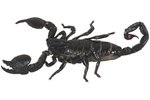
At least three families of spider have horns or hornlike projections -- some on their palps, some on their heads, some on their backs. The most distinctive are the curved spiny spiders or horned spiny orb weavers, with two tremendous horns coming off their backs. These animals are found in tropical Eurasia.
Devilish Darlings
Gasteracantha arcuata is a spider with horns, but he may not be the only one. This genus is large, with at least 70 members cataloged so far; G. arcuata may end up getting split into multiple species or subspecies. These spiders have small bodies, bright colors and mild manners. They're shy, nonaggressive and entirely harmless to humans, yet few spiders are as startling or impressive. Spiny horned spiders have two projections arising from their exoskeletons and stretching several times the length of their bodies. They can have horn spans up to 10 inches. They're confirmed in Indonesia and north into Malaysia, Burma/Myanmar and Thailand, and as far west as India and Sri Lanka. One population is known in the Bukit Timah Hill region of Singapore.
Crabby Relatives
Gasteracantha arcuata has many close relatives that are less remarkable only once you've seen her horns. These are the spiny crablike spiders, all orb weavers of family Arneidae. They have up to six horns coming off their backs, but they're all very short and give the spiders the appearance of crab's carapaces rather than devils' faces. Like other orb weavers, they build distinctive aerial webs in the iconic spiderweb pattern, with a non-sticky area in the center and tufts of silk along some of the threads. These crablike spiders have worldwide distribution, including North America and South America.
Horny Monkeys
Then there are the horned baboon spiders of genus Ceratogyrus, tarantulalike spiders from southern Africa. Rather than building aerial webs, these ground-dwelling ambush hunters excavate burrows and line them with sticky silk sheets to capture prey. They can grow up to 5 inches long; each species has a distinctive but rather small horn projecting from the cephalothorax.
Spiny Mouths
Finally, a small group of diminutive spiders in family Dictynidae, the mesh weavers, sport horns on their palps. Palps are organs near the mouth, sometimes incorrectly called "feelers" or mistaken for fangs. Spiders use them to sense and manipulate prey; males also use them to transfer sperm during breeding. Dictyna longispina, D. calcarata and D. formidolosa accessorize theirs with tiny horns.
References
- A Guide to Common Singapore Spiders: Curved Spiny Spider - Gasteracantha Arcuata
- Project Noah: Horned Spider Gasteracantha Arcuata
- Texas A&M University: Beneficials in the Garden - Spiny Orb Weaver Spider
- Encyclopedia of Life: Gasteracantha
- Animal Diversity Web: Gasteracantha Cancriformis
- BugGuide.net: Species Gasteracantha Cancriformis - Spinybacked Orbweaver
- University of Florida Department of Entomology and Nematology: Common Name - Spinybacked Orbweaver
- National Zoological Gardens of South Africa: Horned Baboon Spider - "Primitive" Spider Sporting a Horn
- Science in Africa: The Baboon Spiders of South Africa
- BugGuide.net: Mesh Web Weavers (Dictynidae)
Photo Credits
-
Brand X Pictures/Stockbyte/Getty Images
Writer Bio
Angela Libal began writing professionally in 2005. She has published several books, specializing in zoology and animal husbandry. Libal holds a degree in behavioral science: animal science from Moorpark College, a Bachelor of Arts from Sarah Lawrence College and is a graduate student in cryptozoology.




